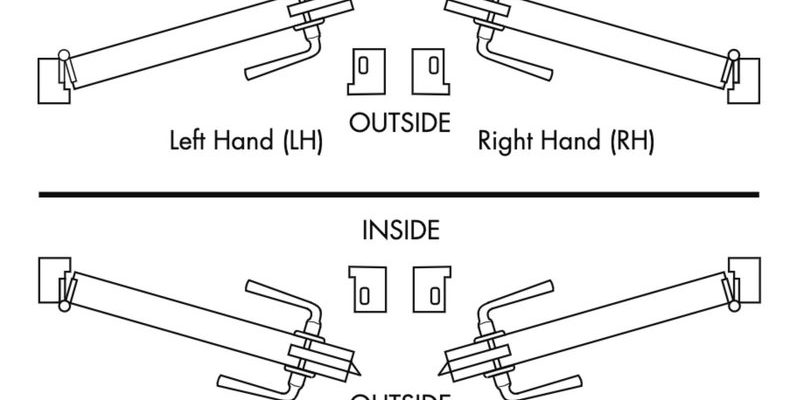
Imagine you’re trying to open a door, but you’re pulling it when you should be pushing. Frustrating, right? That’s why knowing your door handing is so important before you dive into ordering hardware. If you mix it up, you might end up with hinges or locks that just don’t fit your needs. Let’s break it down so that you can confidently navigate your next hardware order.
What is Door Handing?
Door handing refers to how a door is configured in relation to its hinges and how it swings open. Essentially, it determines whether the door is a right-hand or left-hand door. This is crucial when selecting hardware, as the wrong handing can lead to frustration and even additional costs for replacement.
To determine door handing, stand outside the door facing it. If the hinges are on the right side and the door swings toward you, it’s considered a right-hand door. Conversely, if the hinges are on the left and the door swings towards you, it’s a left-hand door. If the door swings away from you, the definitions change slightly. Here, you’d say it’s a right-hand reverse or left-hand reverse, depending on where the hinges are located.
Why Does Door Handing Matter?
You might be wondering why all this matters so much. Well, here’s the thing: if you order the wrong hardware for your door handing, it simply won’t work. Imagine putting a right-hand lock on a left-hand door. Not only is it inconvenient, but it may also compromise security, which isn’t something anyone wants to deal with.
In simple terms, understanding door handing is about more than just knowing how the door opens. It helps streamline the entire process of ordering and installing hardware, saving you time and effort. Plus, it ensures you get the right fit, which can enhance the overall look and functionality of your space.
Steps to Determine Door Handing
Finding the correct handing for your door isn’t as complicated as it may sound. Here are simple steps to follow:
- Step 1: Stand outside the door facing it.
- Step 2: Identify where the hinges are located.
- Step 3: Observe the direction the door swings.
- Step 4: If it swings toward you, it’s either a right or left door. If it swings away, use reverse terms.
It’s all about perspective. Once you’ve identified your door handing, you’ll be ready to order the right hardware.
Common Types of Door Hardware
Now that you understand door handing, let’s talk about the types of hardware you might need. Here are some common components:
- Hinges: These are the moving parts that allow the door to swing.
- Locks: Essential for security, locks must match the handing for optimal function.
- Handles: These come in various styles, and selecting the right one enhances usability.
- Strikes: The part on the doorframe that the lock latches into must also align with your door’s handing.
Using the correct door hardware based on your specific handing ensures that everything fits together seamlessly. It also provides a sense of cohesion in your design, whether you’re building a new home or renovating an existing space.
Comparing Different Hardware Brands
Not all hardware brands are created equal. Some may offer specialized options for specific door handings, while others provide universal fittings. When choosing, consider:
- Quality: Higher-quality hardware might come with a higher price tag, but they often last longer.
- Style: Check that the hardware matches your home’s aesthetic.
- Functionality: Look for options that are user-friendly, especially for high-traffic doors.
Ultimately, your choice will depend on your specific needs, including functionality and design preferences. Picking the right hardware can turn an ordinary door into a functional and stylish entrance.
Ordering Hardware for Your Door
Once you’ve nailed down your door handing and the type of hardware you need, it’s time to place that order. Here’s how to ensure you get exactly what you want:
1. Identify the exact specifications based on the handing you’ve determined.
2. Research brands and suppliers that meet your needs and budget.
3. Double-check the details before finalizing your order to avoid any mistakes.
You might think that placing a hardware order is straightforward, but even small errors can lead to mismatched items. During this process, remember that taking your time will save you from unnecessary headaches down the road.
Final Steps in Installation
After your hardware arrives, take a moment to gather your tools. It’s usually a good idea to have a friend help you, especially if you’re working with heavier doors. Here’s a quick guide to install:
- Step 1: Align the hinges with the door frame.
- Step 2: Secure the hinges with screws.
- Step 3: Install the lock and handle, ensuring it aligns with the strike on the frame.
- Step 4: Test the door to ensure it swings freely and locks properly.
Installation can feel daunting, but taking it step-by-step makes it manageable.
Understanding door handing is essential when it comes to ordering hardware. It’s not just a technical detail; it has real-world implications for how your doors function. By taking the time to determine your door handing, selecting the right hardware, and following a solid installation process, you’ll set yourself up for success.
So next time you’re faced with hardware decisions, remember: it all starts with understanding how your door swings. With the right knowledge, you can confidently tackle any door-related project that comes your way.
